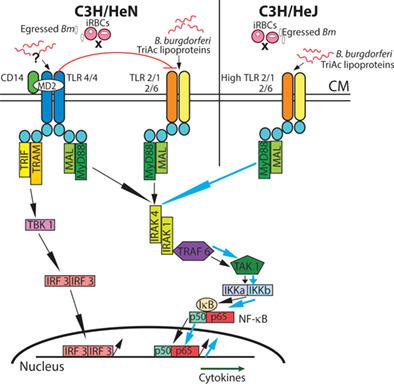当前位置:
X-MOL 学术
›
Cell. Microbiol.
›
论文详情
Our official English website, www.x-mol.net, welcomes your
feedback! (Note: you will need to create a separate account there.)
Pathogenesis of Borrelia burgdorferi and Babesia microti in TLR4-Competent and TLR4-dysfunctional C3H mice
Cellular Microbiology ( IF 2.6 ) Pub Date : 2021-05-02 , DOI: 10.1111/cmi.13350 Lavoisier Akoolo 1 , Vitomir Djokic 1 , Sandra C Rocha 1 , Nikhat Parveen 1
Cellular Microbiology ( IF 2.6 ) Pub Date : 2021-05-02 , DOI: 10.1111/cmi.13350 Lavoisier Akoolo 1 , Vitomir Djokic 1 , Sandra C Rocha 1 , Nikhat Parveen 1
Affiliation

|
Toll-like receptors (TLRs) are a class of membrane-spanning proteins of host cells. TLR2 and TLR4 are displayed on the surface of macrophages, neutrophils and dendritic cells and recognise structurally conserved microbial signatures defined as Pathogen associated molecular patterns (PAMPs). C3H mice are susceptible to tick-borne pathogens; Lyme disease causing Borrelia burgdorferi that manifests arthritis and carditis and Apicomplexan protozoan, Babesia microti (Bm) that causes significant parasitemia associated with erythrocytopenia and haemoglobinuria. B. burgdorferi lacks typical TLR4 ligand lipopolysaccharides (LPS) and Bm TLR ligand(s) remain unknown. Only Borrelia lipoproteins that signal through TLR2 are established as PAMPs of these pathogens for TLR2/TLR4. Infection of C3H mice with each pathogen individually resulted in increase in the percentage of splenic B, T and FcR+ cells while their co-infection significantly diminished levels of these cells and caused increased B. burgdorferi burden in the specific organs. The most pronounced inflammatory arthritis was observed in co-infected C3H/HeJ mice. Parasitemia levels and kinetics of resolution of Bm in both mice strains were not significantly different. Transfected HEK293 cells showed pronounced signalling by B. burgdorferi through TLR2 and to some extent by TLR4 while Bm and infected erythrocytes did not show any response confirming our results in mice.
中文翻译:

TLR4 感受态和 TLR4 功能障碍 C3H 小鼠中伯氏疏螺旋体和小巴贝虫的发病机制
Toll 样受体(TLR) 是宿主细胞的一类跨膜蛋白。TLR2 和 TLR4 显示在巨噬细胞、中性粒细胞和树突状细胞的表面,并识别结构上保守的微生物特征,定义为病原体相关分子模式 (PAMP)。C3H 小鼠对蜱传病原体敏感;莱姆病引起伯氏疏螺旋体,表现为关节炎和心脏炎,以及顶复门原生动物,小巴贝虫( Bm ),导致与红细胞减少症和血红蛋白尿相关的显着寄生虫血症。B. burgdorferi缺乏典型的 TLR4 配体脂多糖 (LPS) 和Bm TLR 配体仍然未知。仅有的通过 TLR2 发出信号的疏螺旋体脂蛋白被确定为这些病原体的 TLR2/TLR4 的 PAMP。用每种病原体单独感染 C3H 小鼠导致脾 B、T 和 FcR+ 细胞的百分比增加,而它们的共同感染显着降低了这些细胞的水平并导致特定器官中的博氏疏螺旋体负担增加。在共同感染的 C3H/HeJ 小鼠中观察到最明显的炎症性关节炎。两种小鼠品系中的寄生虫血症水平和Bm分辨率的动力学没有显着差异。转染的 HEK293 细胞显示B.burgdorferi通过 TLR2 和在一定程度上通过 TLR4 发出明显的信号,而Bm并且受感染的红细胞没有显示任何反应,证实了我们在小鼠中的结果。
更新日期:2021-05-02
中文翻译:

TLR4 感受态和 TLR4 功能障碍 C3H 小鼠中伯氏疏螺旋体和小巴贝虫的发病机制
Toll 样受体(TLR) 是宿主细胞的一类跨膜蛋白。TLR2 和 TLR4 显示在巨噬细胞、中性粒细胞和树突状细胞的表面,并识别结构上保守的微生物特征,定义为病原体相关分子模式 (PAMP)。C3H 小鼠对蜱传病原体敏感;莱姆病引起伯氏疏螺旋体,表现为关节炎和心脏炎,以及顶复门原生动物,小巴贝虫( Bm ),导致与红细胞减少症和血红蛋白尿相关的显着寄生虫血症。B. burgdorferi缺乏典型的 TLR4 配体脂多糖 (LPS) 和Bm TLR 配体仍然未知。仅有的通过 TLR2 发出信号的疏螺旋体脂蛋白被确定为这些病原体的 TLR2/TLR4 的 PAMP。用每种病原体单独感染 C3H 小鼠导致脾 B、T 和 FcR+ 细胞的百分比增加,而它们的共同感染显着降低了这些细胞的水平并导致特定器官中的博氏疏螺旋体负担增加。在共同感染的 C3H/HeJ 小鼠中观察到最明显的炎症性关节炎。两种小鼠品系中的寄生虫血症水平和Bm分辨率的动力学没有显着差异。转染的 HEK293 细胞显示B.burgdorferi通过 TLR2 和在一定程度上通过 TLR4 发出明显的信号,而Bm并且受感染的红细胞没有显示任何反应,证实了我们在小鼠中的结果。











































 京公网安备 11010802027423号
京公网安备 11010802027423号